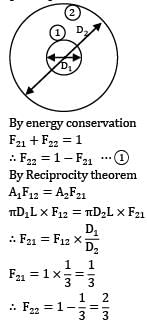Test: Radiative Heat Transfer Level - 1 - Chemical Engineering MCQ
20 Questions MCQ Test - Test: Radiative Heat Transfer Level - 1
A radiator in a domestic heating system operates at a surface temperature of 328K . Assuming the radiator behaves as a black body, the rate at which it emits the radiant heat per unit area is
(Assume σ =5.67 x 10-8 W/m2-k4)
Two radiating surfaces A1= 6m2 and A2=4m2 have shape factor 0.1 Then shape factor will be
What will be the view factor for the geometry as shown in the figure (sphere within a hollow cube)?


For an opaque plane surface at steady state the irradiation, radiosity and emissive power are respectively 20, 12 and . What is the emissivity of the surface?
The wavelength for which the blackbody emissive power is maximum for a temperature of 300 K is
Solar radiation is incident on a semitransparent body at a rate of 500 W/m2. If 150 W/m2 of this incident radiation is reflected back and 225 W/m2 is transmitted across the body, the absorptivity of the body is
The minimum number of view factors that need to be known to solve a 10-surface enclosure completely, is
The spectral distribution of surface irradiation is as follows

What is the total irradiation in kW/m2 ?
Consider two infinitely long blackbody concentric cylinders with a diameter ratio . The shape factor of the inner surface of outer cylinder with respect to itself will be

A large spherical enclosure has a small opening. The rate of emission of radiative flux through this opening is 7.35 kW/m2 . The temperature at the inner surface of the sphere will be about ( assume Stefan Boltzmann constant = 5.67 × 10-8 W/m2K4)
Consider monochromatic emissive power (Eλ) Vs Wavelength(λ) of a black and grey surface both at same temperature. The ratio AB/AC is given as

If the temperature of a solid surface changes from then its emissive power will increases in the ratio of
Consider a hemispherical furnace. The view factor of it’s roof (hemisphere) with respect to itself is __________.
Fraction of radiative energy leaving one surface that strikes the other surface is called
For a gray diffuse surface with emissivity ε and temperature T, the intensity of emitted radiation is given as __________. ( is StefanBoltzmann constant.)
Solar radiation of falls on a grey opaque surface at steady state. The surface has a temperature of and emissivity of 0.8. Find radiosity from the surface?
As the temperature increases, the thermal conductivity of a gas
A gray body is one whose absorptivity:


































